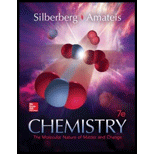
(a)
Interpretation:
For the given reaction mixture, the direction of reaction to proceed in order to reach equilbrium has to be determined
Concept Introduction:
Reaction Quotient:
Reaction quotient, Q is the ratio between product of the product concentration to the product of the reactant concentration with each term raised to the power of its balancing coefficient.
Consider a general equation,
Where a, b, c and d are the stoichiometric coefficients. The reaction quotient is,
Comparison of
When
When
When
(b)
Interpretation:
For the given reaction mixture, the direction of reaction to proceed in order to reach equilbrium has to be determined
Concept Introduction:
Reaction Quotient:
Reaction quotient, Q is the ratio between product of the product concentration to the product of the reactant concentration with each term raised to the power of its balancing coefficient.
Consider a general equation,
Where a, b, c and d are the stoichiometric coefficients. The reaction quotient is,
Comparison of
When
When
When
(c)
Interpretation:
For the given reaction mixture, the direction of reaction to proceed in order to reach equilbrium has to be determined
Concept Introduction:
Reaction Quotient:
Reaction quotient, Q is the ratio between product of the product concentration to the product of the reactant concentration with each term raised to the power of its balancing coefficient.
Consider a general equation,
Where a, b, c and d are the stoichiometric coefficients. The reaction quotient is,
Comparison of
When
When
When
Want to see the full answer?
Check out a sample textbook solution
Chapter 17 Solutions
Chemistry: The Molecular Nature of Matter and Change - Standalone book
 ChemistryChemistryISBN:9781305957404Author:Steven S. Zumdahl, Susan A. Zumdahl, Donald J. DeCostePublisher:Cengage Learning
ChemistryChemistryISBN:9781305957404Author:Steven S. Zumdahl, Susan A. Zumdahl, Donald J. DeCostePublisher:Cengage Learning ChemistryChemistryISBN:9781259911156Author:Raymond Chang Dr., Jason Overby ProfessorPublisher:McGraw-Hill Education
ChemistryChemistryISBN:9781259911156Author:Raymond Chang Dr., Jason Overby ProfessorPublisher:McGraw-Hill Education Principles of Instrumental AnalysisChemistryISBN:9781305577213Author:Douglas A. Skoog, F. James Holler, Stanley R. CrouchPublisher:Cengage Learning
Principles of Instrumental AnalysisChemistryISBN:9781305577213Author:Douglas A. Skoog, F. James Holler, Stanley R. CrouchPublisher:Cengage Learning Organic ChemistryChemistryISBN:9780078021558Author:Janice Gorzynski Smith Dr.Publisher:McGraw-Hill Education
Organic ChemistryChemistryISBN:9780078021558Author:Janice Gorzynski Smith Dr.Publisher:McGraw-Hill Education Chemistry: Principles and ReactionsChemistryISBN:9781305079373Author:William L. Masterton, Cecile N. HurleyPublisher:Cengage Learning
Chemistry: Principles and ReactionsChemistryISBN:9781305079373Author:William L. Masterton, Cecile N. HurleyPublisher:Cengage Learning Elementary Principles of Chemical Processes, Bind...ChemistryISBN:9781118431221Author:Richard M. Felder, Ronald W. Rousseau, Lisa G. BullardPublisher:WILEY
Elementary Principles of Chemical Processes, Bind...ChemistryISBN:9781118431221Author:Richard M. Felder, Ronald W. Rousseau, Lisa G. BullardPublisher:WILEY





